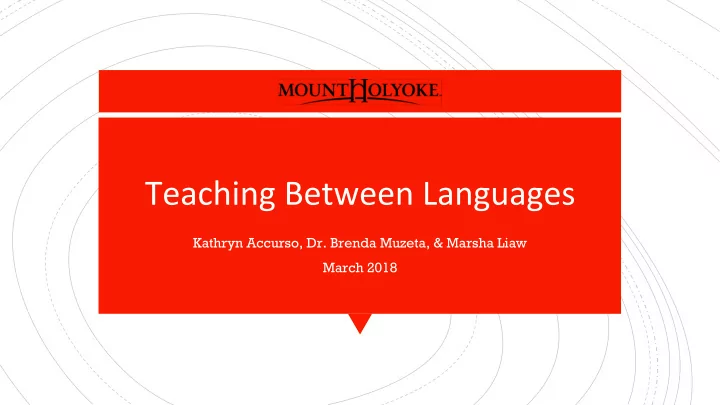

Kathryn Accurso, Dr. Brenda Muzeta, & Marsha Liaw March 2018
“I teach middle school language arts in an urban district. I have 31 students, including four ELLs and a few more whose parents declined services. They’re from all over: Puerto Rico, Thailand, Congo, Eritrea, and Nepal. But I grew up speaking English, only occasionally overhearing Polish phrases from my grandmother. So I have no choice when it comes to the language of my classroom.” ‘Wendy Carr,’ middle school ELA teacher -
20 140 30 110
Quick Poll What language(s) do you speak - currently? What language(s) have you studied? - Have you lived in a different language - community at any point in your life? What language(s) do your students - speak?
20 140 30 110 ‘Superdiversity’ - Vertovec, 2007
P rior knowledge and previous literacy ● practices (L1 oracy and literacy ) ● Major linguistic features of learner’s L1 ● English proficiency levels ● Consideration of cultural knowledge
Linguistically Diverse Classroom T S
Linguistically Diverse Classroom T S
Linguistically Diverse Classroom T S
Write as a Language Learner Try to think and write only in the language 5 minutes you chose. If you need assistance, consult a bilingual dictionary (no google translate!).
Write as a Language Learner
Write as a Language Learner
Our Experiences as Learners
Others’ Experiences “Nothing seemed to come out right – word choices, expressions, or even ideas. When I forced myself to think in English, it seemed I could only squeeze out a Danling Fu few forced ideas, which I could tell were too flat or simple.”
Others’ Experiences “Honestly, some people think we're stupid. But it’s like sometimes people who doesn't even know English get it better than the ones ‘Alberta’, 12 th grade ELL, that do know it. But yeah, WIDA level 5 some people they think, like, ‘They don't know English. They can't do that!’ Like, yes we could. Just give us a try.”
Example ▪ When Chinese students in a high school English class were asked to write about their experience at school in English, most students sat for a long time writing nothing
▪ When allowed to respond to the same prompt in Chinese and translate it afterward, one student wrote: Example Fu, 2009, p. 26
Make writing an everyday part of your teaching. ▪ Informally, formally, and in different genres whatever your content area ▪ Beyond answering questions and copying words from textbooks onto worksheets → writing as thinking, making meaning ▪ Start by having students write about something close to their experience ▪ BREAKFAST EXAMPLE
Embrace the idea that students are not writing only for you. ▪ Students write to present ideas and express themselves ▪ See students’ language(s) as resources for their learning ▪ Create authentic venues for broader communities ▪ EMAIL vs SELF-EXPRESSION EXAMPLE
Create a classroom culture where students are free to choose their language of expression. ▪ Even (or especially!) if it feels overwhelming, scary, or like you’re relinquishing some control ▪ Destabilize English supremacy and normalize multilingualism (e.g., highlight the contributions of diverse thinkers in your content area) ▪ EXAMPLES ▪ What you can do if there are native language partners available ▪ What to do if a student does not have a native language partner
Create a classroom culture where students are free to choose their language of expression. ▪ Analyze how authors move between language varieties and for what purposes More everyday language, conversational tone, “interacts” with reader More disciplinary language, formal tone, distant from reader telling them facts
Create a classroom culture where students are free to choose their language of expression. ▪ Analyze how authors move between language varieties and for what purposes
Create a classroom culture where students are free to choose their language of expression. ▪ Acknowledge and encourage students’ use of their full repertoires to make meaning (languages, images, performance, etc.)
Create a classroom culture where students are free to choose their language of expression. ▪ Allow students to use their full meaning making repertoires ▪ EXAMPLE
1. 2. … … 3. 4. … … 5. 6. 7. 8. 9. 10. … 11. 12. Accurso & Gebhard, 2017
(García ,Johnson & Seltzer, 2017). .
Understand language development and guide students through writing stages ▪ TRANSLANGUAGING CLASSROOM EXAMPLE (experiential to more abstract language; more oral to more written; mode continuum)
Collaborate! Build a discourse community. ▪ Make connections between ESL, bilingual, and content teachers ▪ Quick check-ins about specific students ▪ P. 87-93 of “Writing Between Languages”
Takeaway
Takeaway “ Identities-if they are alive, if they are being lived-are unfinished and in process ” - Norton & Toohey, 2011, p. 429
Takeaway
Takeaway
CUNY NYSIEB www.cuny-nysieb.org “Translanguaging Guide for Educators” “Teaching Bilinguals” web series “The Translanguaging Classroom” “Writing Between Languages” by Danling Fu
MATSOL Currents: up to 1500 words Ed Week: 800–1200 words (opinion piece) TESOL Quarterly: 3400 words (teaching & research issues; abstract must be accepted first)
Recommend
More recommend